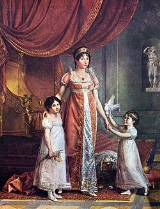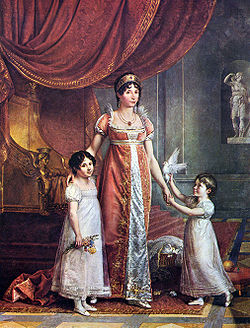
Jean-Baptiste Wicar
Encyclopedia
Jean-Baptiste Wicar was a French Neoclassical painter and art collector.
. The drawings Wicar created of Tableaux, statues, bas-reliefs et camées de la Galerie de Florence et du palais Pitti (Paintings, statues, bas-reliefs and cameos in the Gallery of Florence
and the Pitti Palace) were published in Paris in 4 volumes at the Lacombe publishing house from 1789 to 1807.
Wicar headed the commission set up by Napoleon I of France
to loot artworks from the Austrian Netherlands to enrich museums in France - an initial convoy left Antwerp on 11 August 1794, notably with paintings by Rubens
, for the Louvre
. Abbeys and castles were systematically emptied of their contents, furniture and works of art. Wicar was also a member of the commission des sciences et des arts on the Italian campaign
, in the entourage of Bonaparte
. This commission was charged with seizing artworks that could enrich French national museum collections. He finally permanently settled in Rome in 1800 and became a portraitist of European renown.
On his death in Rome, Wicar left the major collection of 1,300 drawings he had accumulated over his lifetime to the Société des Sciences, de l’Agriculture et des Arts de Lille. Mostly from the Italian school, but also in some small measure from the northern schools, it held drawings by artists like Raphael
, Albrecht Dürer
, Lucas Cranach
, Nicolas Poussin
and Jacques-Louis David
. This legacy initially formed the public "musée Wicar", which in 1866 merged into the Palais des beaux-arts de Lille
.

Life
The son of a carpenter, Wicar studied drawing at the free school in Lille before further honing his talents in the studio of DavidJacques-Louis David
Jacques-Louis David was an influential French painter in the Neoclassical style, considered to be the preeminent painter of the era...
. The drawings Wicar created of Tableaux, statues, bas-reliefs et camées de la Galerie de Florence et du palais Pitti (Paintings, statues, bas-reliefs and cameos in the Gallery of Florence
Uffizi
The Uffizi Gallery , is a museum in Florence, Italy. It is one of the oldest and most famous art museums of the Western world.-History:...
and the Pitti Palace) were published in Paris in 4 volumes at the Lacombe publishing house from 1789 to 1807.
Wicar headed the commission set up by Napoleon I of France
Napoleon I of France
Napoleon Bonaparte was a French military and political leader during the latter stages of the French Revolution.As Napoleon I, he was Emperor of the French from 1804 to 1815...
to loot artworks from the Austrian Netherlands to enrich museums in France - an initial convoy left Antwerp on 11 August 1794, notably with paintings by Rubens
Rubens
Rubens is often used to refer to Peter Paul Rubens , the Flemish artist.Rubens may also refer to:- People :Family name* Paul Rubens Rubens is often used to refer to Peter Paul Rubens (1577-1640), the Flemish artist.Rubens may also refer to:- People :Family name* Paul Rubens (composer) Rubens is...
, for the Louvre
Louvre
The Musée du Louvre – in English, the Louvre Museum or simply the Louvre – is one of the world's largest museums, the most visited art museum in the world and a historic monument. A central landmark of Paris, it is located on the Right Bank of the Seine in the 1st arrondissement...
. Abbeys and castles were systematically emptied of their contents, furniture and works of art. Wicar was also a member of the commission des sciences et des arts on the Italian campaign
French Revolutionary Wars: Campaigns of 1796
The French Revolutionary Wars continued from 1795, with the French in an increasingly strong position as members of the First Coalition made separate peaces. Austria and Great Britain were the main remaining members of the coalition...
, in the entourage of Bonaparte
Napoleon I of France
Napoleon Bonaparte was a French military and political leader during the latter stages of the French Revolution.As Napoleon I, he was Emperor of the French from 1804 to 1815...
. This commission was charged with seizing artworks that could enrich French national museum collections. He finally permanently settled in Rome in 1800 and became a portraitist of European renown.
On his death in Rome, Wicar left the major collection of 1,300 drawings he had accumulated over his lifetime to the Société des Sciences, de l’Agriculture et des Arts de Lille. Mostly from the Italian school, but also in some small measure from the northern schools, it held drawings by artists like Raphael
Raphael
Raffaello Sanzio da Urbino , better known simply as Raphael, was an Italian painter and architect of the High Renaissance. His work is admired for its clarity of form and ease of composition and for its visual achievement of the Neoplatonic ideal of human grandeur...
, Albrecht Dürer
Albrecht Dürer
Albrecht Dürer was a German painter, printmaker, engraver, mathematician, and theorist from Nuremberg. His prints established his reputation across Europe when he was still in his twenties, and he has been conventionally regarded as the greatest artist of the Northern Renaissance ever since...
, Lucas Cranach
Lucas Cranach the Elder
Lucas Cranach the Elder , was a German Renaissance painter and printmaker in woodcut and engraving...
, Nicolas Poussin
Nicolas Poussin
Nicolas Poussin was a French painter in the classical style. His work predominantly features clarity, logic, and order, and favors line over color. His work serves as an alternative to the dominant Baroque style of the 17th century...
and Jacques-Louis David
Jacques-Louis David
Jacques-Louis David was an influential French painter in the Neoclassical style, considered to be the preeminent painter of the era...
. This legacy initially formed the public "musée Wicar", which in 1866 merged into the Palais des beaux-arts de Lille
Palais des Beaux-Arts de Lille
The Palais des Beaux-Arts de Lille is one of the largest museums in France, and the largest French museum outside of Paris....
.
Works

- Boutigny-sur-EssonneBoutigny-sur-EssonneBoutigny-sur-Essonne is a commune in the Essonne department in Île-de-France in northern France.It is located between Étampes and Corbeil-Essonnes....
, church, St John the Baptist and Saint Sebastian - Naples, Galleria Nazionale di Capodimonte, Portrait of Marie-Julie Bonaparte and her daughters, Zénaïde and Charlotte.
- Paris, Musée du Louvre, Portrait of Jacques-Louis DavidJacques-Louis DavidJacques-Louis David was an influential French painter in the Neoclassical style, considered to be the preeminent painter of the era...
,, given to the Louvre in 1998. - LilleLilleLille is a city in northern France . It is the principal city of the Lille Métropole, the fourth-largest metropolitan area in the country behind those of Paris, Lyon and Marseille. Lille is situated on the Deûle River, near France's border with Belgium...
, Musée des Beaux-ArtsPalais des Beaux-Arts de LilleThe Palais des Beaux-Arts de Lille is one of the largest museums in France, and the largest French museum outside of Paris....
, Portrait of general MuratJoachim MuratJoachim-Napoléon Murat , Marshal of France and Grand Admiral or Admiral of France, 1st Prince Murat, was Grand Duke of Berg from 1806 to 1808 and then King of Naples from 1808 to 1815...
.
Sources
- Fernand Beaucamp : Le peintre lillois Jean Baptiste Wicar (1762 1834) son oeuvre et son temps (Lille, 1939, 2 vols).
- Maria Teresa Caracciolo et Gennaro Toscano : Jean-Baptiste Wicar et son temps 1762-1834 (Villeneuve d’Ascq: Presses Universitaires du Septentrion, 2007).
External links
- http://www.artcyclopedia.com/artists/wicar_jean-baptiste_joseph.html

